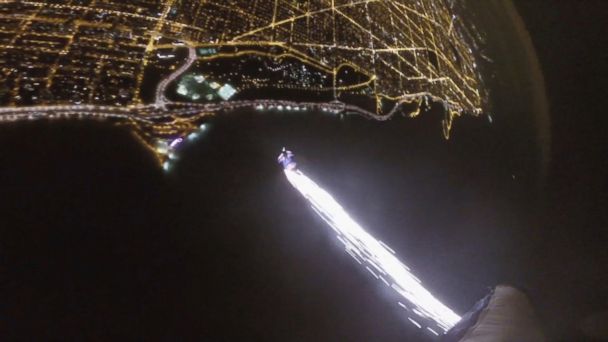Red Bull 'Meteor' Lights Up Sky and Internet
A "meteor" that streaked over Chicago Monday night prompted speculation of extraterrestials and zooming space junk, but turned out to be the Red Bull Air Force.
The streaking light was seen over the city about 6:30 p.m., but today the energy drink company said it was responsible for the light show.

Red Bull skydivers jumped with flares over Chicago on the evening of Nov. 4, 2014 to promote the opening of the Red Bull Art of Can event. Red Bull
The streaks were made by a trio of divers in wing suits carrying flares.
"Last night, at approximately 6:25pm, the Red Bull Air Force, consisting of Jon Devore, Mike Swanson and Sean MacCormac jumped into high wings, sprang flares and landed safely onto the Lake Michigan shoreline at Castaways to kick of Red Bull Art of Can!" the company said in a statement.
Fireball Meteor Called Bolide Lights Up Japanese Sky
Mysterious Bright, Greenish Object Streaks Across the Sky
The event features local artists in Chicago's Millennium Park.
The Red Bull wing jumpers soared at the same time, however, that meteors were being spotted elsewhere, one over West Virginia and another that startled sky watchers in Japan.
Paul Abell, lead scientist for Planetary Small Bodies at NASA's Johnson Space Center in Houston, said that Earth is bombarded by about 100 tons of natural debris every single day.
The fireball captured by a West Virginia police sergeant's dashcam was likely created by something roughly the size of a baseball.
Objects that size across typically burn up completely as they reenter the atmosphere, posing no danger to people on the ground.
"The rule of thumb is that for objects to make it to the ground and actually survive, they need to be at least a meter or bigger," Abell told ABC News. "For things that move high speed, a hyper-velocity impact where you're causing a lot of damage, an impact crater and a large nuclear-type explosion, you have to be on the order of about 20 meters."
That's about the size of the Chelyabinsk meteor that exploded over Russia in February 2013, sending out a shock wave that shattered windows and injured roughly 1,500 people on the ground.
"We live in a very busy place,"Abell says. "So at NASA we have this grand challenge to find all the asteroid threats to human populations and know what to do about them."
Expect a lot of smaller shooting stars over the next few days, Abell says, thanks to the annual Taurids meteor shower. The Taurids are created as Earth passes through the dusty tail of a comet known as Encke.
"We have a lot of material floating around and the Earth sweeps it up as it moves through space," says Abell.